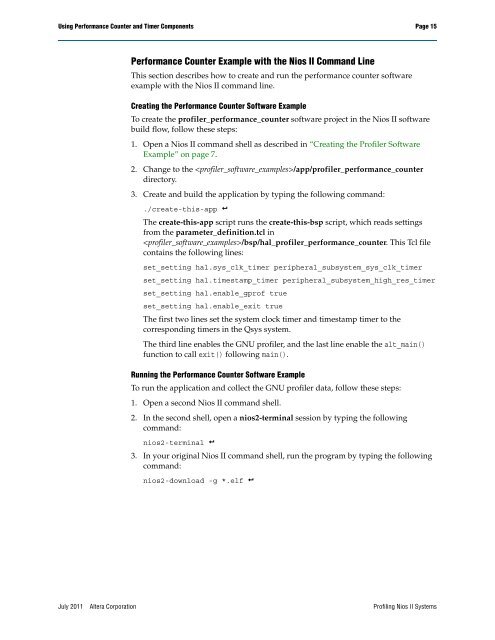Profiling Nios II Systems Application Note 391 - Altera
Profiling Nios II Systems Application Note 391 - Altera
Profiling Nios II Systems Application Note 391 - Altera
Create successful ePaper yourself
Turn your PDF publications into a flip-book with our unique Google optimized e-Paper software.
Using Performance Counter and Timer Components Page 15<br />
Performance Counter Example with the <strong>Nios</strong> <strong>II</strong> Command Line<br />
This section describes how to create and run the performance counter software<br />
example with the <strong>Nios</strong> <strong>II</strong> command line.<br />
Creating the Performance Counter Software Example<br />
To create the profiler_performance_counter software project in the <strong>Nios</strong> <strong>II</strong> software<br />
build flow, follow these steps:<br />
1. Open a <strong>Nios</strong> <strong>II</strong> command shell as described in “Creating the Profiler Software<br />
Example” on page 7.<br />
2. Change to the /app/profiler_performance_counter<br />
directory.<br />
3. Create and build the application by typing the following command:<br />
./create-this-app r<br />
The create-this-app script runs the create-this-bsp script, which reads settings<br />
from the parameter_definition.tcl in<br />
/bsp/hal_profiler_performance_counter. This Tcl file<br />
contains the following lines:<br />
set_setting hal.sys_clk_timer peripheral_subsystem_sys_clk_timer<br />
set_setting hal.timestamp_timer peripheral_subsystem_high_res_timer<br />
set_setting hal.enable_gprof true<br />
set_setting hal.enable_exit true<br />
The first two lines set the system clock timer and timestamp timer to the<br />
corresponding timers in the Qsys system.<br />
The third line enables the GNU profiler, and the last line enable the alt_main()<br />
function to call exit() following main().<br />
Running the Performance Counter Software Example<br />
To run the application and collect the GNU profiler data, follow these steps:<br />
1. Open a second <strong>Nios</strong> <strong>II</strong> command shell.<br />
2. In the second shell, open a nios2-terminal session by typing the following<br />
command:<br />
nios2-terminal r<br />
3. In your original <strong>Nios</strong> <strong>II</strong> command shell, run the program by typing the following<br />
command:<br />
nios2-download -g *.elf r<br />
July 2011 <strong>Altera</strong> Corporation <strong>Profiling</strong> <strong>Nios</strong> <strong>II</strong> <strong>Systems</strong>
















